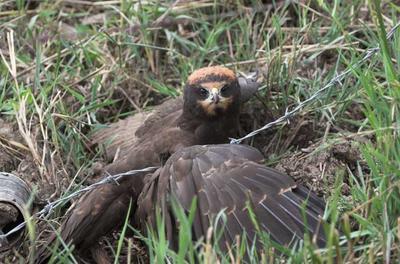



On July 18th 2005 I was checking on the productivity of a number of Marsh Harrier nests, in conjunction with the National Survey, on the south bank of the Humber. At 05:00 the brood of four young from one nest were all on the wing with a newly fledged juvenile from an adjacent nest nearby. Having checked on some other nests I returned to the area at 10:00 to find only three juveniles in the area with the adult male which was distress calling. A further search located a juvenile hanging by its right wing from a barbed wire fence. I assumed the bird was dead but as I approached it fluttered revealing that the wing was skewered at the carpal joint. There was no way that the bird could escape from this lethal fencing as the barbs went right through the skin of the wing. The bird was clearly in huge distress and had been pecking at the wound with blood over its bill and feet. I could not remove the wire which was embedded in the wing but managed to break one end of the wire and after extricating the birds claw from my finger I walked the mile back to the nearest human habitation and managed to borrow some wire cutters and a shopping bag. The bird was cut free leaving part of the wire in the wing and delivered to the nearest vet. Obviously it was fortunate that I was in the area at the time, a day or so later and the juvenile harrier would have died a lingering death from starvation and heat exhaustion on this lethal fencing.
The dangers of barbed wire to birds are seldom highlighted but I have previously found dead owls, Redshank and Lapwing hanging or killed by flying into barbed wire fencing.
The danger posed by deer fencing to Black Grouse and Capercaillie has led to its removal from reserves in Scotland but in England the proliferation of the lethal cocktail of barbed wire fences and convenient posts for perching birds has spread to large numbers of nature reserves where birds at risk include owls, raptors and waders. Surely on nature reserves at least there are better less lethal methods of fencing?









